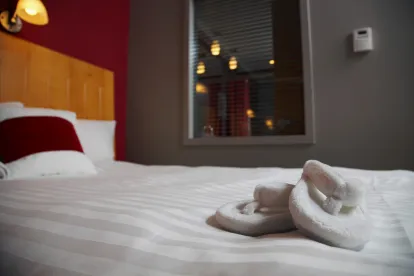Decision Date: March 31, 2015
Court: U.S. Patent Trial and Appeal Board
Patents: D622,531
Holding: Examiner’s decision in reexamination proceeding not to adopt Requester’s obviousness rejections REVERSED
Opinion: Sealy Technology LLC owns U.S. Design Patent No. D622,531, entitled “Euro-top Mattress Design.” Simmons Bedding Company requested an inter partes reexamination of the ’531 patent (Reexamination Control 95/001,549), proposing numerous rejections of the claim over a total of 73 prior art exhibits as either anticipated or obvious. The Examiner declined to adopt the proposed rejections and closed prosecution. Simmons appealed to the Board.
The Examiner determined that the ’531 patent included six elements in the claimed design. The Examiner found that three of the references disclose the first three elements: (1) a thick, straight-sided pillow top layer that is (2) one-third the thickness of the mattress layer and is (3) attached to the mattress and shares piping with the top of the mattress. But the Examiner found that these references do not disclose the fourth element, eight flat vertical handles with two on each side. The Examiner reasoned that because the references only show two sides of a mattress, “no assumption can be made” that handles are located on the other sides. But the Board found the Examiner’s position to be untenable because Simmons submitted unrebutted evidence in an expert report that one of ordinary skill would have understood the mattresses in each of the prior art references to include matching handles on the sides that were not shown.
In addition, because the anticipation standard of review is whether the prior art is “substantially similar in the eyes of the ordinary observer armed with the knowledge of the prior art,” Int’l Seaway Trading Corp. v. Walgreens Corp., 589 F.3d 1233, 1237–38, 1240 (Fed. Cir. 2009), the Board reasoned that an ordinary observer would have judged the similarity of the references and the claimed design based on the view shown in the references. Thus, the Board found that the Examiner erred in failing to infer handles on the sides that were not shown in the prior art. However, since the prior art references did not explicitly disclose all eight handles, the Board focused on obviousness instead of anticipation.
In its obviousness analysis, the Board agreed with the Examiner that the three references disclose the first three elements and further found that two additional references depicted the first three elements. The Board also inferred flat vertical handles on the sides not shown. Thus, the Board found these five references to be proper Rosen references. In re Rosen 673 F.2d 388, 391 (CCPA 1982). According to the Board, any differences between the references and the claimed design, such as bowed handles instead of flat handles or a lack of handles on an end, were insignificant or trivial differences that do not change the overall appearance and would have been obvious.
The Examiner did not analyze the remaining two elements, the contrast of the piping and the handles, but the Board found that the standard of contrasting is only one of differing appearance from the other portions of the mattress. Because each of the five references included piping and handles that could easily be distinguished, the Board found that the references also disclosed these elements. Accordingly, the Board reversed the Examiner’s decision not to adopt the proposed obviousness rejections over these five references. This reversal constituted new grounds of rejection, giving Sealy the opportunity to either request rehearing or reopen prosecution. Sealy elected to reopen prosecution, which is ongoing.





 />i
/>i

